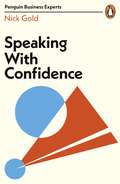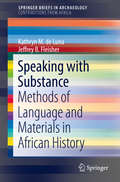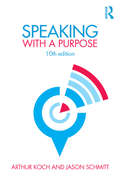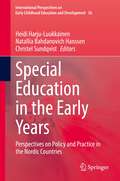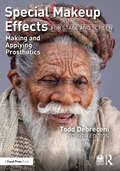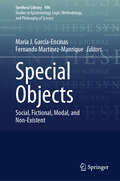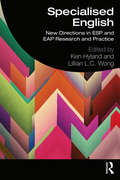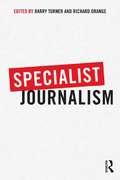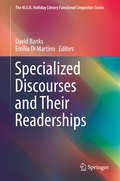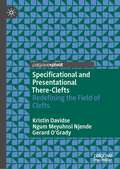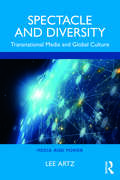- Table View
- List View
Speaking the Unspeakable in Postwar Germany: Toward a Public Discourse on the Holocaust
by Sonja BoosSpeaking the Unspeakable in Postwar Germany is an interdisciplinary study of a diverse set of public speeches given by major literary and cultural figures in the 1950s and 1960s. Through close readings of canonical speeches by Hannah Arendt, Theodor W. Adorno, Ingeborg Bachmann, Martin Buber, Paul Celan, Uwe Johnson, Peter Szondi, and Peter Weiss, Sonja Boos demonstrates that these speakers both facilitated and subverted the construction of a public discourse about the Holocaust in postwar West Germany. The author's analysis of original audio recordings of the speech events (several of which will be available on a companion website) improves our understanding of the spoken, performative dimension of public speeches. While emphasizing the social constructedness of discourse, experience, and identity, Boos does not neglect the pragmatic conditions of aesthetic and intellectual production--most notably, the felt need to respond to the breach in tradition caused by the Holocaust. The book thereby illuminates the process by which a set of writers and intellectuals, instead of trying to mend what they perceived as a radical break in historical continuity or corroborating the myth of a "new beginning," searched for ways to make this historical rupture rhetorically and semantically discernible and literally audible.
Speaking with Confidence (Penguin Business Experts Series)
by Nick GoldDoes the thought of delivering a presentation make your heart skip a beat? Do your pitches fall flat no matter how much preparation you put in? Are you often comparing yourself to more eloquent speakers and wondering how they capture the room?At some point in our careers we will need to speak in front of an audience; whether to present our ideas to a group of five in a meeting, pitch for investment in front of a panel or deliver a keynote speech to one thousand delegates. Yet glossophobia, or the fear of public speaking, is incredibly common and can inhibit our chances of career progression by up to 15%. In Speaking with Confidence, Expert and managing director of Speakers' Corner Nick Gold, shows how anyone can learn to be a confident public speaker and use their surroundings to give them the support and structure they need to achieve maximum impact and success from their speech. His decades of experience coaching and producing some of the best speakers in the country have been condensed here into one expert guide to help you connect with your audience every time.
Speaking with Houses: A Cross-Cultural Critique of Heidegger’s Ontology
by Michael LinzeyThis book critically examines the concept of “Being” in Western philosophy and its manifestation in architecture.The book traverses diverse cultural and historical contexts, analysing five architectural works: the Djoser Step Pyramid in ancient Egypt, the Pantheon in imperial Rome, the Tai-an tea house in late medieval Japan, the Te Tokanganui-a-Noho meeting house in colonial New Zealand and Mies van der Rohe’s Seagram Building in modern New York. Through these case studies, it challenges Martin Heidegger’s assertion that “language is the house of Being,” proposing instead that “Being” is a construct specific to Western ontology. By exploring architectural poiesis across various cultures, the book reveals that the Western notion of “Being” is not a universal foundation for architectural creation. Each examined structure embodies distinct cultural and philosophical principles, such as the concept of mū in Japanese tea houses, which signifies “neither Being nor non-Being,” and the “no-Being” tradition in Māori tikanga. This comparative analysis underscores the diversity of architectural expressions and their underlying philosophies, offering readers a nuanced understanding of how different cultures conceptualize existence and space.This book is an invaluable resource for scholars in architecture, philosophy and cultural studies. Its interdisciplinary approach provides a comprehensive critique of Western metaphysical assumptions, encouraging readers to reconsider the relationship between language, being, and architectural form. By integrating architectural analysis with philosophical inquiry, it fosters a deeper appreciation of cultural diversity in architectural practices and invites academics to explore alternative ontological perspectives in the built environment.
Speaking with Substance: Methods of Language and Materials in African History (SpringerBriefs in Archaeology)
by Kathryn M. de Luna Jeffrey B. FleisherThis volume proposes a supplemental approach to interdisciplinary historical reconstructions that draw on archaeological and linguistic data. The introduction lays out the supplemental approach, situating it in the broader context of similar interdisciplinary research methods in other world regions. Reflecting the arguments of the volume and its goal to document the process rather than the outcome of interdisciplinary collaboration, the volume is organized into two two-chapter case studies. Within each case study, the non-specialist develops an historical interpretation using their own research findings and published data from the other discipline.This chapter is followed by critical commentary from the specialist, a dialogue clarifying the commentary and specialists’ methods, and a second short historical interpretation that deploys insights from the supplemental approach. The conclusion reflects on the challenges of disciplinary conventions to interdisciplinary research and the contribution of the supplemental approach to efforts to know the history of oral societies in Africa and beyond
Speaking with a Purpose
by Arthur Koch Jason SchmittNow in its 11th edition, Speaking with a Purpose is designed to help speakers develop the skills they need to prepare and deliver effective speeches. Using a traditional step-by-step approach combined with up-to-date communication theory, this no-frills textbook allows students to prepare, practice, and present speeches. This new edition places greater emphasis on the skills needed to communicate effectively both online and offline. It analyses the similarities and differences between in-person speaking and online video conferencing and explores technical online attributes such as best Zoom protocols. This new edition also provides a deeper focus on the ethics and ethical implications associated with communicating in public and assesses issues such as trustworthiness, integrity, and respect for others. A valuable resource in the traditional, online, or hybrid classroom, this is an essential textbook for general courses in public speaking and speech communication and composition. Online resources for instructors include a fully updated test bank and an Instructor’s Manual containing learning objectives and discussion questions. They are available online at https://www.routledge.com/9781032502700.
Speaking with a Purpose
by Arthur Koch Jason SchmittNow in its 10th edition, Speaking with a Purpose is designed to help speakers develop the skills they need to prepare and deliver effective speeches. Based on a traditional step-by-step approach combined with up-to-date communication theory, this no-frills text allows students more time to prepare, practice, and present speeches. This edition includes two brand new chapters, both with a technological focus. Students and instructors can also enjoy updated online ancillary material with resources for each chapter. This text is a valuable resource in the traditional, online, or hybrid classroom.
Special Chinese Birthdays
by Nicole Wong Jessica QuiltyThe fun and excitement of English and Language Arts learning continues in Grade 2 of Reading Street. This comprehensive and dynamic curriculum for homeschooling is geared toward young children who have some foundational English and Language Arts knowledge and are ready to strengthen their skills. Comprised of engaging activities, challenging content and weekly quizzes, Reading Street: Grade 2 is the next step in your child's path toward becoming a lifelong learner and reader. As with all Reading Street products, the Grade 2 system is formatted to help students meet certain age-appropriate goals. After completing this English and Language Arts homeschool program, your child should be able to: Read and comprehend two-syllable words. Identify common prefixes (such as pre-, un-, or re-) and suffixes (such as -able, -ad and -er). Correct mistakes made when reading out loud. Read books with two or more chapters. Understand the structure of stores (i. e. beginning, middle and end). Start selecting reading materials based on his/her own interests. Identify the "who," "what," "when," "where," "why" and "how" of the text. While the goals of second Grade English and Language Arts are numerous, Reading Street will help you craft engrossing lessons. Your child will garner important English and Language Arts skills while completing a workbook, reading stories and poems, and taking assessments. Planning these lessons will be easier than ever, as all Reading Street systems are broken down into weekly Big Ideas. All the work your child does on a given week is formulated around that single concept for an organized and challenging curriculum. With six easy-to-follow units, Reading Street: Grade 2 is the perfect tool for homeschooling parents. Your child will enjoy the reading selections and activities, and you'll love to see your student growing into a knowledgeable individual. We're confident that this product is the right one for you. For more information on the specific materials found in Grade 2 of Reading Street, check out the Features and Benefits page.
Special Education Considerations for English Language Learners: Delivering a Continuum of Services
by Else Hamayan Jack Damico Barbara MarlerThis important guide shows how to determine appropriate interventions for ELLs with academic challenges. It includes extensive new discussions of RtI and standardized testing used for diagnostic purposes and and reviews consequences for ELLs. The ensuring a continuum of services model featured in the book is a strong collaborative framework that takes teams of educators step-by-step through gathering information about and implementing effective interventions for ELLs with learning difficulties.
Special Education Considerations for Multilingual Learners: Delivering a Continuum of Services
by Else Hamayan Jack Damico Barbara Marler Cristina Sanchez-LopezDo you know how to identify and support multilingual learners with special education needs? Learn how to proactively meet the needs of multilingual learners by creating a culturally and linguistically responsive multi-tiered system of support (MTSS) and implementing a continuum of services. The third edition of this groundbreaking text shifts the focus away from traditional approaches to special education and offers a powerful alternative for educators dedicated to equity for all multilingual learners, including those experiencing challenges at school. Chapters have been fully updated to reflect the latest best practices and reorganized to better align with MTSS. Special Features, MTSS team activities to support professional learning, Checklists, rating scales, and other reproducible tools, Real-world chronicles from the field, Discussion questions to help teams apply the concepts to their own student population Book jacket.
Special Education in the Early Years: Perspectives on Policy and Practice in the Nordic Countries (International Perspectives on Early Childhood Education and Development #36)
by Heidi Harju-Luukkainen Natallia Bahdanovich Hanssen Christel SundqvistThis book explores policies and practices in special education in the early years, highlighting shared enablers and barriers. It examines research, policies and practices from different Nordic countries and discusses the theory and empirical data underlying the research. It looks at specific issues including gifted children, social inequality and exclusion, teaching children with autism, inclusive practice, language and emotions. The book offers critical perspectives, highlights potential developmental objects and gives recommendations for further research as well as policy and practice. The book features many aspects of the so-called Nordic model - the economic and social policies common to the Nordic Countries: Denmark, Finland, Norway and Sweden. The findings provide important insights into the Nordic model and advance the understanding of relevant issues facing the Nordic countries.
Special Makeup Effects for Stage and Screen: Making and Applying Prosthetics
by Todd DebreceniWith this new edition of Special Makeup Effects for Stage and Screen, author Todd Debreceni presents the latest techniques and special effects in what has become an industry "bible." In addition to genre-specific considerations, Debreceni covers the latest gear you will need and details how to maintain your kit, how to take care of the actor's skin, how to airbrush for HD, and much more. With in-depth, step-by-step tutorials, learn how to sculpt and mold your own makeup prosthetics, focusing on human anatomy to create the most realistic effects. This new and expanded edition features updated information on lifecasting, prosthetics made using 3D printing, advanced airbrushing techniques, and new artist profiles, and includes updated images and illustrations throughout. A companion website contains artist profiles that showcase some of the world’s top makeup effects artists, including Ve Neill, Matthew W. Mungle, and many others. Also included are detailed tutorials led by experts in the field, such as Matthew Mungle, Adrian Rigby, Stuart Bray, and of course, the author himself.
Special Objects: Social, Fictional, Modal, and Non-Existent (Synthese Library #496)
by Maria J. García-Encinas Fernando Martínez-ManriqueThis book proposes a different perspective on actual queries within the field of ontology. Focusing on non-standard objects, it offers original answers to classic problems in metaphysics, such as individuation, reference, existence and non-existence. The chosen ontological fields are, for this purpose, ontologies that essentially involve human social practices such as intentional objects, fictions, mental illnesses or social entities. Even though the papers can be read independently, readers will discover a number of original intersections that provide fresh points of entry to contemporary metaphysical issues. By dealing with entities that are not so frequently addressed in related works, the book also contributes to broaden their perspective on ontology. Both scholars and students will find it particularly useful to have a survey about non-standard abstract entities that can provide new topics for their research.
Specialised English: New Directions in ESP and EAP Research and Practice
by Ken Hyland Lillian L WongSpecialised English: New Directions in ESP and EAP Research and Practice provides an authoritative and cutting-edge account of the latest avenues of research and practice in the dynamic field of Specialised English. Ken Hyland and Lillian Wong present 17 specially commissioned chapters by some of the world’s leading experts to offer discussions of key topics in research, theory and pedagogy from a variety of international perspectives. Divided into three sections, which focus on conceptual issues, text and classroom practice, this book: Offers a clear and accessible introduction to current issues in EAP and ESP, including academic interaction, academic lingua franca, second language publishing, workplace talk, practitioner identity, data-driven learning and critical thinking Includes studies of a range of genres such as research articles and student reports, student spontaneous speech, personal statements, builders’ diaries and university tutorials Presents links between theory and practice with a sampling of different research methodologies, practical applications and theoretical approaches Specialised English is essential reading for upper-level undergraduate and postgraduate students and researchers in EAP/ESP and applied linguistics, as well as pre- and in-service teachers and teacher educators.
Specialised Translation: Shedding the 'Non-Literary' Tag (Palgrave Studies in Translating and Interpreting)
by M. RogersThis book shifts the common perception of specialised or 'LSP' translation as necessarily banal and straightforward towards a more realistic understanding of it as a complex and multilayered phenomenon which belies its standard negative binary definition as 'non-literary'.
Specialist Journalism
by Barry Turner and Richard OrangeCombining practical 'how to' skills with reflection on the place of each specialism in the industry, this guide features the skills needed to cover specialist areas, including writing match reports for sport, reviewing the arts, and dealing with complex information for science. The book will also discuss how specialist journalists have contributed to the mainstream news agenda, as well as analysing how different issues have been covered in each specialism, such as the credit crunch, global warming, national crime statistics and the celebrity culture in sport. Areas covered include: Sport Business Politics Crime Environment Fashion Food Music Media Science Health Law Travel War Wine
Specialized Discourses and Their Readerships (The M.A.K. Halliday Library Functional Linguistics Series)
by David Banks Emilia Di MartinoThis volume studies the relationship between the writers of specialized text and their readers in a broad range of settings, including research, popularization and education. It offers younger researchers an insight into the targeting process, helping them consider the impact their work can have, and showing them how to achieve greater exposure. Further, it offers an invaluable reflective instrument for beginning and experienced researchers, drawing on a veritable treasure trove of their colleagues’ experience. As such, it represents a way for researchers and students in linguistics and related disciplines to access issues from a different, insider perspective.Reader targeting has become a very sophisticated process, with authors often addressing their potential readers even in video. Compared to other forms of writing, academic writing stands out because authors are, in the majority of cases, also consumers of the same type of products, which makes them excellent “targeters.”
Specialized Knowledge Mediation: Ontological & Metaphorical Modelling
by Ekaterina IsaevaThis book provides an integrated approach to cognitive-linguistic mediation, with aims toward the efficiency of knowledge transfer and acquisition. Problems are approached through the prism of cognitive modelling, and mapped to such fields as intercultural and interdisciplinary communication, and second language teaching. The novelty lies in the synergies between linguistics, cognitive science, artificial intelligence, culture, and industry. These fields come together through ontological and metaphorical modelling and the attempts to automate such. This text provides a theoretical background for research on mediation, covering cognitive and communicative perspectives, metaphoricity of terms, and the ontologization of human knowledge. It includes detailed descriptions of methods for different types of cognitive modelling and is intended for students and researchers concerned with terminology, cognitive linguistics, applied linguistics, pragmatics, computational linguistics, literature studies, morphology, syntaxis, and semantics.
Specialized Program Individualizing Reading Excellence (SPIRE) Workbook: Level 4 (3rd Edition)
by Sheila Clark-EdmandsSPECIALIZED PROGRAM INDIVIDUALIZING READING EXCELLENCE S.P.I.R.E® is a comprehensive, multisensory reading intervention program that integrates phonological awareness, phonics, fluency, vocabulary, spelling, comprehension, and handwriting. Based on the Or ton-Gillingham approach, S.P.I.R.E. incorporates the most recent research regarding best practices in reading instruction. S.P.I.R.E. is systematically structured, and follows a 10-Step lesson plan that ensures students experience continuous and visible success.
Specialized Program Individualizing Reading Excellence, Level I (S.P.I.R.E.)
by Sheila Clark-EdmandsSpecialized Program Individualizing Reading Excellence *S.P.I.R.E 3rd Edition Reader Level I
Specialized Program Individualizing Reading Excellence: Reader Level 4 (3rd Edition)
by Sheila Clark-EdmandsS.P.I.R.E [Specialized Program Individualizing Reading Excellence] is a multi-sensory teaching approach utilizing systematic, sequential phonics and phonological awareness in grades kindergarten through eight. S.P.I.R.E. is an early intervention and prevention of reading failure program in reading and written language.
Specific Learning Differences, What Teachers Need to Know (Second Edition): Embracing Neurodiversity in the Classroom
by Diana HudsonThe updated, straight-talking and accessible guide is ideal for teachers, teaching assistants, SENCOs, senior leadership and even home schooling parents who want to know more about supporting students with Learning Differences.Highlighting some of the more commonly encountered Specific Learning Differences (SpLD's), expert Diana Hudson concisely describes the signs of those that are most commonly encountered in the classroom. Covering: dyslexia, dyspraxia, dyscalculia, dysgraphia, autism spectrum condition, ADHD, OCD and featuring brand new chapters on Pathological Demand Avoidance (PDA), Sensory Processing Disorder (SPD) and tics and Tourette Syndrome, this book covers all the information you need, whilst reminding us that all neurodivergent children are individuals and have different qualities.Diana provides an overview of each identity and evaluates how you may need to adapt your levels of support in the classroom - as well as practical suggestions for modifying teaching materials and methods to make learning enjoyable, effective and accessible for all students. There are also dedicated chapters on helping students with SpLD's to improve their organisation and develop effective revision skills and exam techniques.
Specificational and Presentational There-Clefts: Redefining the Field of Clefts
by Gerard O'Grady Kristin Davidse Ngum Meyuhnsi NjendeThis book proposes a radically new account of clefts in English. Since the 1960s, functional as well as formal linguists have generally restricted clefts to constructions with an identifying matrix (it-clefts) and have claimed that they only code information structure. Clefts are assumed to unpack a simple proposition into a focus – presupposition structure. In this book, the authors reject these theoretical-descriptive assumptions, arguing instead that clefts form a field comprising it-clefts, there-clefts and ‘have’-clefts. They show that, like any other construction, clefts compositionally code propositional semantics, onto which a great variety of prosodically coded focus patterns may be mapped. The authors fundamentally challenge the existing approach by entering the debate with an in-depth account of the neglected specificational and presentational there-clefts, offering the first systematic data-based study of their grammatical and prosodic features. While the study is restricted to English, its findings have significant cross-linguistic relevance. This book will be of interest to students and scholars of Functional, Cognitive and Formal Linguistics, Corpus Linguistics, and usage-based study of grammar and prosody.
Spectacle Earth: Media for Planetary Change (Cultural Frames, Framing Culture)
by Andrew KalaidjianArtistic, literary, and technological depictions of the climate crisis and how they influence humanity&’s response What does it mean to watch a disaster unfold? Does exposure to a source of dread spur people to action or lull them into fatalism and complacency? Andrew Kalaidjian takes up these and other vital questions in Spectacle Earth, a lively and wide-ranging consideration of media engagement, passivity, and virtual environments in relation to ecological crises and climate change. Kalaidjian begins by tracing the long trajectory of environmental aesthetics and natural sciences that have led up to the Anthropocene. He then looks at the lessons learned from artist and activist movements of the 1960s and 1970s before laying out the new challenges in the digital age of artificial intelligence, cloud computing, and virtual reality. The result is groundbreaking, offering readers a new media literacy that goes beyond individual therapeutic experience to provide forms of expression that can lead to the sorts of solidarity and connection needed to change the planet for the better.
Spectacle and Diversity: Transnational Media and Global Culture (ISSN)
by Lee ArtzThis book shows how transnational media operate in the contemporary world and what their impact is on film, television, and the larger global culture. Where a company is based geographically no longer determines its outreach or output. As media consolidate and partner across national and cultural boundaries, global culture evolves. The new transnational media industry is universal in its operation, function, and social impact. It reflects a shared transnational culture of consumerism, authoritarianism, cultural diversity, and spectacle. From Wolf Warriors and Sanju to Valerian: City of 1000 Planets and Pokémon, new media combinations challenge old assumptions about cultural imperialism and reflect cross-boundary collaboration as well as boundary-breaking cultural interpretation. Intended for students of global studies and international communication at all levels, the book will appeal to a wide range of readers interested in the way transnational media work and how that shapes our culture.
Spectacle and Diversity: Transnational Media and Global Culture (Media and Power)
by Lee Burton ArtzThis book shows how transnational media operate in the contemporary world and what their impact is on film, television, and the larger global culture. Where a company is based geographically no longer determines its outreach or output. As media consolidate and partner across national and cultural boundaries, global culture evolves. The new transnational media industry is universal in its operation, function, and social impact. It reflects a shared transnational culture of consumerism, authoritarianism, cultural diversity, and spectacle. From Wolf Warriors and Sanju to Valerian: City of 1000 Planets and Pokémon, new media combinations challenge old assumptions about cultural imperialism and reflect cross-boundary collaboration as well as boundary-breaking cultural interpretation. Intended for students of global studies and international communication at all levels, the book will appeal to a wide range of readers interested in the way transnational media work and how that shapes our culture.

